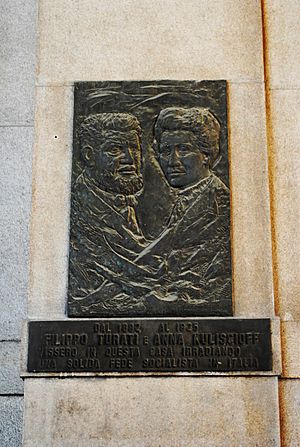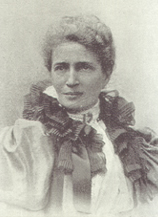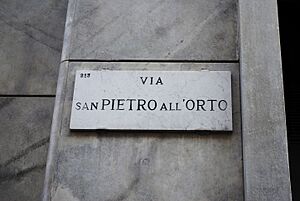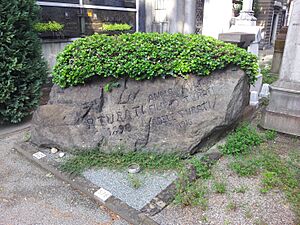Anna Kuliscioff facts for kids
Quick facts for kids
Anna Kuliscioff
|
|
|---|---|

Anna Kuliscioff (1908)
|
|
| Born |
Anna Moiseyevna Rozenshtein
9 January 1857 Moskaya near Simferopol, Taurida Governorate, Russian Empire
|
| Died | 27 December 1925 (aged 68) |
| Spouse(s) | Pyotr Makarevich |
| Partner(s) | Andrea Costa Filippo Turati |
Anna Kuliscioff (Russian: Анна Кулишёва, IPA: [ˈanːə kʊlʲɪˈʂovə]; born Anna Moiseyevna Rozenshtein, Анна Моисеевна Розенштейн; 9 January 1857 – 27 December 1925) was a brave woman from Russia who became a doctor and a strong voice for change in Italy. She was born Anna Moiseyevna Rozenshtein on January 9, 1857, and passed away on December 27, 1925. She believed in fairness for everyone, especially women, and worked hard to improve society. She was one of the first women to become a doctor in Italy.
| Top - 0-9 A B C D E F G H I J K L M N O P Q R S T U V W X Y Z |
Anna Kuliscioff's Life Story
Anna Kuliscioff was born in 1857 near Simferopol, in Crimea. Her father, Moisei, was a successful Jewish merchant. This meant her family had special rights in the Russian Empire.
Early Years and Education
Anna's real name was Anna Moiseevna Rozenstejn. She came from a wealthy Jewish family. Her parents made sure she had a good childhood and excellent education. She studied philosophy at the University of Zurich in Switzerland. Anna had an amazing memory and was very good at thinking logically. She was encouraged to study with private teachers from a young age. She became interested in politics very early on.
In 1871, after learning several foreign languages, Anna went to study engineering at the Zürich Polytechnic. She also took philosophy classes there. The city was full of people who had been forced to leave their home countries for political reasons. These people introduced her to new ideas about fairness and equality. In 1873, she stopped her engineering studies and married Pyotr Makarevich, who was also a revolutionary. They returned to Russia and worked with groups trying to bring change. They worked first in Odessa and then in Kiev.
In 1874, Pyotr Makarevich was sent to prison for his political activities and sadly died there. To avoid being arrested herself, Anna escaped from Odessa. She lived secretly, first in Kiev and then in Kharkov. She often sang in public parks to earn money. In Kiev, she joined revolutionaries who took strong actions against the government. When her friends in this group were arrested, she managed to escape again.
Moving to Italy and Political Work
In April 1877, Anna left Russia using a fake passport and moved to Paris. There, she joined a small group that believed in getting rid of the state, following the ideas of Mikhail Bakunin. One member was an Italian man named Andrea Costa. They started a relationship that lasted for many years. During this time, they were often separated because they were arrested or forced to leave countries. It was in Paris that police records first called her Kuliscioff, a name that showed she came from the East.
After being forced to leave France in 1878, Anna moved to Italy. In 1891, she became the editor of Critica Sociale, an important socialist newspaper. She worked hard for causes like women's suffrage, which means the right for women to vote. Because of her activism, Anna Kuliscioff was tried and imprisoned several times.
Her ideas about Marxism (a political and economic theory) greatly influenced Filippo Turati, who became her partner. Together, they helped create the Italian Socialist Party (PSI). They led a group within the party that wanted gradual changes, not sudden revolutions. This group disagreed with both Communism and the strong nationalist ideas of Benito Mussolini. Mussolini later left the PSI. In 1921, Anna and Filippo's group was also expelled from the PSI. This led them to form a new party, the Unitary Socialist Party (PSU), with Giacomo Matteotti. They stood against the rising power of Fascism.
Anna was romantically involved first with Andrea Costa and then with Filippo Turati. She helped both of them understand and support Marxism. Because of this, she was called "the strong woman of Italian socialism." A journalist once said that Anna had the best political mind in Italian socialism. He added that everyone, even Mussolini, respected and admired her.
Her Final Years
In 1912, the government passed a law that allowed all men to vote, even those who couldn't read. But this law used illiteracy as a reason to not let women vote. This was a very difficult time for Anna Kuliscioff. She felt discouraged and abandoned. Her political disagreements with Turati mixed with personal issues, making life harder.
Anna Kuliscioff's last years were filled with sadness and health problems. The socialist movement also faced many divisions. At the same time, the Fascist Party was growing stronger. Anna Kuliscioff passed away on December 27, 1925. Even her funeral procession on December 29, 1925, in Milan, was met with violence. Some fascists attacked the carriages, tearing drapes and crowns. This turned her funeral into a symbol of the growing conflict.
Medical Career
Starting Her Medical Studies
Because she couldn't be as active in politics for a while, Anna focused more on her university studies. In 1882, she had to move to Switzerland, where she enrolled in medical school. Medicine allowed her to focus on an individual goal and also helped her fulfill her desire to help society. She had spent a lot of time in prison and had caught tuberculosis. Doctors recommended warmer climates for her health. So, in 1884, she moved to Naples with her daughter, Andreina Costa.
Anna's Ideas on Puerperal Fever
Because of slow paperwork, Anna decided to continue her medical research elsewhere. She first went to Turin, where she met Cesare Lombroso and his daughters. Then, in 1885, she moved to Pavia. There, she worked in one of the most famous laboratories, led by Camillo Golgi, who later won a Nobel Prize.
For her graduation thesis, Anna chose to study puerperal fevers. These fevers were a major cause of death for women after childbirth. This was an exciting area of research, especially with new discoveries in microbiology. Also, in Italy, there were new ideas about "social medicine," which connected health with a democratic and socialistic ideology.
Anna bravely suggested that the infection was caused not by a streptococcus (as Louis Pasteur thought), but by other tiny organisms called proteins of putrefaction. At first, Golgi supported her idea. However, the next year, other scientists in his lab disagreed with her. Her graduation thesis was her only scientific publication, and it was printed in the "Gazzetta degli Ospedali" newspaper.
The Doctor for the Poor
After finishing her thesis, Anna returned to the University of Naples. In 1886, she became the first woman to graduate in medicine and surgery from that university. After graduating, she moved again in 1887 to specialize in medicine in Padua. In 1888, she specialized in gynecology (women's health), first in Turin, then in Padua. Choosing gynecology showed Anna's dedication to helping women. This way, she could combine her medical work with her political goals.
During these years, she was in a relationship with Filippo Turati. She decided to move to Milan with him. She tried to get a job as a doctor at the Maggiore Hospital, but she was turned down because she was a woman.
After her attempts at an academic and hospital career, she started working as a "doctor of the poor" at via San Pietro all'Olmo 18. She offered free medical help to poor women. Being a doctor for the poor showed her the difficult living conditions of workers in Milan. She wanted to use her political influence to help them. Becoming a "doctor of the poor" was a strong act of her will.
People truly admired her work. Her daily visits were seen as a great help. It was more than just a doctor's visit; Anna Kuliscioff was seen as a comforter, a friend, and a trusted woman by those who suffered. Her patients said she understood their deepest feelings. She treated poor people with kindness and warmth. Kuliscioff didn't only treat the poor; even wealthy ladies from the bourgeoisie trusted her care.
Sadly, her health problems meant she couldn't continue this work for too long. She retired to her home but continued her active political work from there. Over the 20th century, more and more women started studying medicine and working in hospitals and healthcare.
Selected Works
- Il monopolio dell'uomo: conferenza tenuta nel circolo filologico milanese, Milan, Critica sociale, 1894 (The Monopoly of Man)
- Il voto alle donne: polemica in famiglia per la propaganda del suffragio universale in Italia, Milan, Uffici della critica sociale, 1910 (with Filippo Turati, in Italian)
- Proletariato femminile e Partito socialista: relazione al Congresso nazionale socialista 1910, Milan, Critica sociale, 1910
- Donne proletarie, a voi...: per il suffragio femminile, Milan, Società editrice Avanti!, 1913
- Lettere d'amore a Andrea Costa, 1880–1909, Milan, Feltrinelli, 1976
- Amore e socialismo. Un carteggio inedito, La nuova Italia, 2001 (with Filippo Turati, in Italian)
See also
 In Spanish: Anna Kulishova para niños
In Spanish: Anna Kulishova para niños





